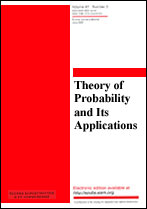|
This article is cited in 4 scientific papers (total in 4 papers)
Resource allocation in communication networks with large number of users:
the dual stochastic gradient method
D. B. Rokhlinab
a Institute of Mathematics, Mechanics and Computer Sciences, Southern Federal University, Rostov-on-Don
b Regional mathematical center of Southern Federal University, Rostov-on-Don
Abstract:
We consider a communication network with a fixed set of links that are shared
by a large number of users. The resource allocation is performed on the basis
of the aggregate utility maximization in accordance with the popular approach
proposed by F. Kelly and coauthors in 1998. The problem is to construct
a pricing mechanism for transmission rates in order to stimulate an optimal
allocation of the available resources. In contrast to the usual approach, the
proposed algorithm does not use the information on the aggregate traffic over
each link. This algorithm's inputs are the total number $N$ of users, the
link capacities, and optimal myopic reactions of randomly selected users to
the current prices. The dynamic pricing scheme is based on the dual
stochastic gradient projection method. For a special class of utility
functions $u_i$, we obtain upper bounds for the constraint residuals and for
the deviation of the objective function from the optimal value. These
estimates are uniform in $N$ and of order $O(T^{-1/4})$ in the number $T$ of
measured user reactions.
We present the results of computer experiments for quadratic functions $u_i$,
which are the differences between the linear utilities,
which are individual for each user, and the quadratic penalty assigned by the
network.
Keywords:
network utility maximization, duality, stochastic gradient projection method, large number of users.
Received: 03.07.2019
Revised: 19.09.2019
Accepted: 12.09.2019
Citation:
D. B. Rokhlin, “Resource allocation in communication networks with large number of users:
the dual stochastic gradient method”, Teor. Veroyatnost. i Primenen., 66:1 (2021), 129–148; Theory Probab. Appl., 66:1 (2021), 105–120
Linking options:
https://www.mathnet.ru/eng/tvp5336https://doi.org/10.4213/tvp5336 https://www.mathnet.ru/eng/tvp/v66/i1/p129
|


| Statistics & downloads: |
| Abstract page: | 295 | | Full-text PDF : | 78 | | References: | 45 | | First page: | 8 |
|




 Contact us:
Contact us: Terms of Use
Terms of Use
 Registration to the website
Registration to the website Logotypes
Logotypes








 Citation in format
Citation in format 
